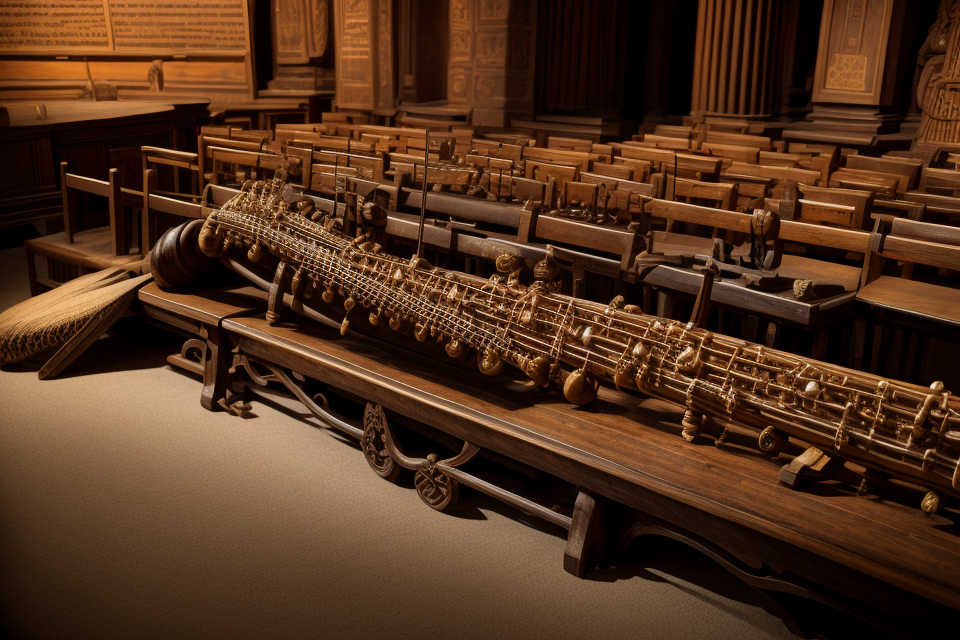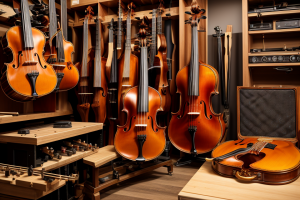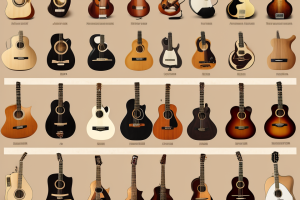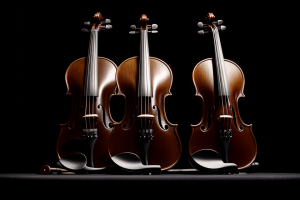
The history of music is as old as the history of mankind itself. Throughout the ages, music has been an integral part of human culture, with instruments being invented and developed to create melodies and harmonies. But have you ever wondered which instrument is the oldest in the world? In this comprehensive investigation, we will delve into the depths of history to uncover the oldest instrument known to man. Join us as we embark on a journey through time to explore the antiquity of this ancient instrument and discover how it has shaped the course of music history.
The History of Musical Instruments: A Brief Overview
The Evolution of Musical Instruments
Throughout history, musical instruments have played a crucial role in human societies, serving as a means of communication, expression, and entertainment. From ancient civilizations to modern times, musical instruments have evolved significantly, reflecting the cultural, technological, and artistic advancements of their respective eras.
In the earliest stages of human history, musical instruments were simple and rudimentary, crafted from natural materials such as wood, bone, and stone. These early instruments were often used in rituals and ceremonies, and their sounds were believed to have mystical and spiritual significance.
As societies became more complex, so too did the instruments used to create music. The invention of the lyre, for example, marked a significant milestone in the evolution of musical instruments, allowing for greater versatility and precision in musical expression.
Over time, musical instruments continued to evolve, with the development of new materials and technologies enabling the creation of increasingly sophisticated and expressive instruments. From the harpsichord to the piano, from the violin to the electric guitar, each new instrument brought with it new possibilities for musical expression, opening up new realms of sound and creativity.
Today, the world of musical instruments is vast and diverse, encompassing a wide range of styles, genres, and traditions. From the classical concert hall to the rock concert stage, from the jazz club to the electronic dance party, musical instruments continue to play a central role in human expression and culture, reflecting the ever-evolving nature of human creativity and innovation.
The Significance of Early Instruments in Human History
The significance of early instruments in human history cannot be overstated. These instruments played a crucial role in the development of human culture and society. They were used for a variety of purposes, including religious rituals, entertainment, and communication. In many cases, these instruments were also used as a form of artistic expression, allowing people to express themselves creatively and connect with others on a deeper level.
One of the most significant ways in which early instruments impacted human history was through their role in the development of music. Music has been a vital part of human culture for thousands of years, and early instruments played a crucial role in its evolution. These instruments allowed people to create and enjoy a wide range of musical styles, from simple melodies to complex compositions.
Another important aspect of the significance of early instruments is their role in the development of technology. Many of these instruments were made using advanced techniques and materials, and their design and construction required a high level of skill and craftsmanship. This led to the development of new technologies and techniques, which in turn had a profound impact on other areas of human endeavor.
Finally, early instruments were also significant because they provided a means of communication and connection between people. In many cultures, music was used as a way to convey important messages and ideas, and the instruments used to create this music played a crucial role in this process. Additionally, the act of playing music together can bring people closer together and foster a sense of community and shared experience.
Overall, the significance of early instruments in human history cannot be overstated. They played a crucial role in the development of music, technology, and communication, and their impact can still be felt today.
The Importance of Identifying the Oldest Instrument in the World
The quest to identify the oldest instrument in the world is a fascinating pursuit that has captivated scholars, archaeologists, and music enthusiasts alike. The study of musical instruments not only sheds light on the evolution of human culture and artistry but also provides insights into the technological advancements of ancient civilizations.
There are several reasons why identifying the oldest instrument in the world is crucial. Firstly, it helps us understand the origins of music and how it has evolved over time. By studying the oldest instrument, we can gain insights into the musical traditions of ancient civilizations and how they influenced modern music.
Secondly, identifying the oldest instrument in the world can provide valuable information about the technological capabilities of ancient societies. Musical instruments often reflect the level of craftsmanship and technological advancement of a civilization, and studying the oldest instrument can help us understand how far humanity has come in terms of technological development.
Lastly, identifying the oldest instrument in the world can also have significant cultural and historical significance. Many musical instruments are deeply rooted in cultural traditions, and identifying the oldest instrument can provide insights into the cultural practices and beliefs of ancient societies. It can also help us appreciate the value of preserving cultural heritage and the importance of maintaining cultural traditions.
In conclusion, identifying the oldest instrument in the world is a critical pursuit that can provide valuable insights into the evolution of human culture, technology, and artistry. It is a pursuit that requires extensive research, collaboration, and a deep appreciation for the significance of musical instruments in human history.
Theories on the Oldest Instrument in the World
The Ocarina: A Leading Contender for the Oldest Instrument
The ocarina is a wind instrument that has been around for centuries, and it is widely regarded as one of the oldest instruments in the world. It is a simple instrument consisting of an enclosed space with holes along its sides, and it is played by blowing air into it and covering and uncovering the holes. The ocarina’s origins are shrouded in mystery, but there are several theories about its antiquity.
One theory suggests that the ocarina originated in ancient Greece, where it was used in religious ceremonies and festivals. The instrument was believed to have been played by the gods themselves, and it was considered a sacred object. According to this theory, the ocarina spread to other parts of the world through trade and cultural exchange, eventually becoming a popular instrument in many different cultures.
Another theory suggests that the ocarina originated in China, where it was used in court and military music. The instrument was highly valued by the Chinese emperors, who commissioned elaborate works to be composed for it. The ocarina’s popularity in China eventually spread to other parts of Asia, and it became an important instrument in many traditional Asian music styles.
Despite these theories, there is no conclusive evidence to support the origins of the ocarina. Some scholars believe that the instrument may have originated independently in different parts of the world, while others believe that it may have been invented by a single culture and then spread to others.
Regardless of its origins, the ocarina has had a significant impact on the world of music. Its simple design and versatility have made it a popular instrument in many different cultures, and it continues to be played and enjoyed by musicians and audiences alike.
The Xun: A Possible Earlier Instrument
The Xun is a traditional Chinese instrument that is similar to the modern-day flute. It is made from bamboo and has a distinctive sound that has captivated musicians for centuries. Some experts believe that the Xun may be the oldest instrument in the world, predating even the flute.
There are several theories as to how the Xun originated. One theory suggests that it was developed during the Neolithic period, around 9,000 years ago. At this time, bamboo was widely available and was used for a variety of purposes, including as a building material and for making tools. It is possible that early humans discovered that bamboo could also be used to make musical instruments.
Another theory suggests that the Xun was developed during the Xia Dynasty, which ruled from around 2100 to 1600 BCE. During this time, bamboo was used to make a variety of musical instruments, including the bamboo chime, which is still played today. It is possible that the Xun evolved from the bamboo chime, or that it was developed independently.
Despite the theories, there is no concrete evidence to support the origin of the Xun. However, its unique sound and construction suggest that it has been around for a very long time, and may indeed be the oldest instrument in the world.
The Divine Lute: A Legendary Ancient Instrument
Origins of the Legend
The legend of the Divine Lute dates back to ancient times, originating from the mythologies of various cultures. In Greek mythology, it is said to have been crafted by the god Hermes and gifted to the musician Orpheus, who used it to enchant the gods with his melodies. Similarly, in Chinese mythology, the Divine Lute is attributed to the legendary musician and emperor, Huangdi, who was said to have invented the instrument himself.
Symbolism and Significance
The Divine Lute holds great symbolic significance in many cultures. It is often seen as a symbol of power, creativity, and spiritual connection. In Greek mythology, the instrument is said to have the power to charm even the gods themselves, while in Chinese mythology, it is believed to have the power to bring harmony and balance to the world.
Historical Evidence
Despite its legendary status, there is little concrete evidence of the existence of the Divine Lute in historical records. However, there are several ancient texts that mention the instrument, including the Chinese Shiji and the Greek poet Homer’s Odyssey. These texts provide insight into the cultural significance of the Divine Lute and its role in ancient society.
The Search for the Divine Lute
Over the centuries, many scholars and archaeologists have sought to uncover the truth behind the legend of the Divine Lute. While some have claimed to have found ancient lutes that resemble the legendary instrument, there is no concrete evidence to prove that any of these artifacts are the true Divine Lute. The search for this ancient instrument continues to this day, with many still hoping to uncover the secrets of this legendary musical relic.
The Search for the Oldest Instrument: Challenges and Findings
The Difficulty in Identifying the Oldest Instrument
Establishing a Definition for an Instrument
One of the primary challenges in identifying the oldest instrument is the need to establish a clear definition of what constitutes an instrument. This is a subjective determination, as some scholars may consider a device to be an instrument if it was used to produce music, while others may require that it have a specific shape or purpose. This lack of a universally accepted definition makes it difficult to determine which artifact should be considered the oldest instrument.
The Limited Availability of Surviving Instruments from Antiquity
Another challenge in identifying the oldest instrument is the scarcity of surviving instruments from antiquity. Many ancient instruments were made from perishable materials, such as wood, bone, and skin, which have not survived the passage of time. Additionally, many ancient instruments were destroyed or lost during wars, natural disasters, or other catastrophic events. As a result, the number of surviving instruments from antiquity is limited, making it difficult to determine which one is the oldest.
The Inaccuracy of Historical Records
Historical records can also be a source of confusion when attempting to identify the oldest instrument. Many ancient texts have been lost or destroyed, and those that survive may contain inaccuracies or inconsistencies. For example, some historical records describe instruments that could not have existed in the time period they are attributed to, while others describe instruments that may have been misidentified or misunderstood.
The Subjectivity of Dating Methods
Finally, the dating of ancient instruments can be subjective and unreliable. Carbon dating, radiocarbon dating, and other scientific methods can provide a rough estimate of the age of an artifact, but they are not always accurate. Additionally, some instruments may have been modified or repaired over time, making it difficult to determine their original age.
Overall, the difficulty in identifying the oldest instrument is a result of the subjective nature of defining an instrument, the limited availability of surviving instruments from antiquity, the inaccuracy of historical records, and the subjectivity of dating methods. These challenges make it difficult to determine with certainty which artifact should be considered the oldest instrument in the world.
Archaeological Discoveries and Their Impact on the Search
Significant Archaeological Finds and Their Implications
One of the most significant archaeological discoveries that have impacted the search for the oldest instrument is the discovery of the Neanderthal flute. This flute, which is made from the wing bone of a bird, was found in the cave of Divje Babe in Slovenia and is believed to be around 50,000 years old. This find has provided valuable insight into the musical capabilities of our early ancestors and has helped to push back the timeline of human musical expression.
Advancements in Technology and Their Role in the Search
Advancements in technology have also played a significant role in the search for the oldest instrument. With the development of more sophisticated dating techniques and the ability to analyze materials at a molecular level, researchers have been able to uncover new information about ancient instruments and the cultures that created them. Additionally, the use of computer modeling and simulation has allowed researchers to recreate ancient instruments and better understand their construction and sound production.
The Importance of Collaboration in the Search
Finally, the search for the oldest instrument has also been impacted by the importance of collaboration between researchers from different fields. Archaeologists, musicologists, and scientists have all contributed to the search, bringing their unique perspectives and expertise to the table. This interdisciplinary approach has been crucial in uncovering new information about ancient instruments and pushing the boundaries of what we know about human musical expression.
The Current State of Research and Debate
- Academic Journals and Publications
- Archaeological and Musicological Research: Scholarly journals and publications dedicated to archaeology and musicology have contributed significantly to the search for the oldest instrument. Researchers in these fields have explored ancient artifacts and remains to uncover evidence of early musical instruments.
- Anthropological Studies: Anthropological research has also played a vital role in understanding the evolution of musical instruments across cultures. Researchers have studied ancient cultures and their musical traditions to gain insights into the origins of musical instruments.
- International Collaboration
- Global Expert Network: Experts from various fields, including archaeology, musicology, anthropology, and history, have formed a global network to share their knowledge and findings. This collaborative effort has helped to identify and date ancient musical instruments more accurately.
- Cross-Cultural Exchange: The exchange of information and resources between different cultures has also contributed to the search for the oldest instrument. Researchers have been able to compare and contrast musical traditions and instruments across cultures, providing valuable insights into the evolution of musical instruments.
- Technological Advancements
- Carbon Dating and Radiometric Dating Techniques: Technological advancements in dating techniques, such as carbon dating and radiometric dating, have enabled researchers to more accurately date ancient artifacts and remains. These techniques have provided valuable information about the age of the oldest instrument.
- Digital Imaging and Analysis Tools: The development of digital imaging and analysis tools has also enhanced the search for the oldest instrument. These tools have allowed researchers to analyze and study ancient artifacts in greater detail, providing new insights into their construction and use.
- Public Interest and Funding
- Public Engagement: The search for the oldest instrument has generated significant public interest, which has led to increased funding for research in this area. Public support has enabled researchers to access resources and technology necessary for their investigations.
- Grants and Sponsorships: The search for the oldest instrument has also attracted sponsorships and grants from various organizations and institutions. This funding has enabled researchers to conduct extensive studies and excavations, which have contributed to the ongoing investigation.
The current state of research and debate surrounding the search for the oldest instrument is characterized by the collaborative efforts of experts from various fields, technological advancements, and public interest and funding. These factors have played a crucial role in shaping the current understanding of the antiquity of the oldest instrument in the world.
The Cultural Significance of Ancient Instruments
The Role of Instruments in Ancient Cultures
Instruments have played a significant role in ancient cultures throughout history. They have been used for various purposes, including religious ceremonies, entertainment, and communication. In many ancient civilizations, instruments were considered to be sacred objects that possessed mystical powers and were used in rituals to appease the gods.
In ancient Egypt, for example, instruments were used in religious ceremonies to honor the gods and goddesses. The Egyptians believed that the gods controlled the elements, and instruments were used to invoke their power and protect the people from natural disasters. The Egyptians also used instruments in their funerary practices, believing that the sound of music could help the soul of the deceased on their journey to the afterlife.
In ancient Greece, instruments were used in theater and music performances. The Greek philosopher Aristotle wrote about the importance of music in human life, stating that it had the power to evoke emotions and change people’s moods. The Greeks also used instruments in their military campaigns, using trumpets and drums to signal commands and rally troops.
In ancient China, instruments were used in court music and opera performances. The Chinese believed that music had the power to heal the body and mind and used it in traditional medicine. They also used instruments in religious ceremonies, such as the use of gongs and cymbals in Buddhist and Taoist rituals.
Overall, instruments have played a significant role in ancient cultures, serving as a means of communication, entertainment, and spiritual expression.
The Preservation and Revival of Ancient Instruments
The Importance of Preserving Ancient Instruments
In recent years, there has been a growing appreciation for the importance of preserving ancient instruments as cultural heritage. These instruments hold significant historical and cultural value, and their preservation ensures that future generations can appreciate and learn from them.
Conservation Techniques for Ancient Instruments
Conservation techniques for ancient instruments are becoming increasingly sophisticated, with experts using a range of methods to restore and preserve these artifacts. From cleaning and restoration to replication and reproduction, conservation specialists are working to ensure that these instruments remain in good condition for years to come.
Collaboration Between Conservators and Scholars
Collaboration between conservators and scholars is crucial in the preservation of ancient instruments. By working together, experts can develop a better understanding of the materials and techniques used in the creation of these instruments, as well as the cultural and historical context in which they were used.
Reviving Ancient Instruments for Modern Performance
Another important aspect of preserving ancient instruments is reviving them for modern performance. By studying ancient music and performance practices, modern musicians can bring these instruments back to life, providing audiences with a unique insight into the cultural practices of the past.
The Challenges of Reviving Ancient Instruments
However, reviving ancient instruments for modern performance is not without its challenges. Musicians must grapple with issues such as tuning, performance techniques, and the use of unfamiliar instruments, all while staying true to the cultural context in which the instruments were originally used.
The Role of Technology in Preserving and Reviving Ancient Instruments
Technology is also playing an increasingly important role in the preservation and revival of ancient instruments. From 3D printing to digital reconstructions, technological advancements are allowing conservators and musicians to create accurate replicas of ancient instruments and to better understand their construction and use.
The Ethics of Replicating Ancient Instruments
However, there are also ethical considerations to be made when replicating ancient instruments. Should replicas be used in performance, or should only the original instruments be used to preserve their authenticity? These are important questions that must be considered in the preservation and revival of ancient instruments.
The Continuing Appeal of Ancient Instruments in Modern Times
In recent times, there has been a renewed interest in ancient instruments among musicians, scholars, and the general public. This section will explore the reasons behind this enduring appeal.
Revival of Ancient Instruments in Classical Music
One of the primary reasons for the continuing appeal of ancient instruments is their revival in classical music. In the 20th century, musicians began to rediscover and recreate ancient instruments, such as the harpsichord, lute, and viola da gamba. These instruments were often used in period performances of Baroque and Renaissance music, which aimed to recreate the sound and style of the music as it would have been heard in the past.
The Role of Museums and Exhibitions
Museums and exhibitions have also played a significant role in the continuing appeal of ancient instruments. Many museums around the world have collections of ancient instruments, which are displayed to the public. These exhibitions allow people to see and hear these instruments up close, providing insight into their construction, sound, and historical significance.
The Allure of Antiquity
Finally, the allure of antiquity itself has contributed to the continuing appeal of ancient instruments. People are fascinated by the history and culture of the past, and ancient instruments represent a tangible link to bygone eras. By playing or listening to ancient instruments, people can experience a sense of connection to the past and gain a deeper appreciation of the historical context of the music.
In conclusion, the continuing appeal of ancient instruments in modern times can be attributed to their revival in classical music, their presence in museums and exhibitions, and the allure of antiquity itself. These factors have contributed to a renewed interest in ancient instruments and have helped to preserve their cultural significance for future generations.
The Future of Research on the Oldest Instrument in the World
Advancements in Technology and Their Impact on Research
Technological Advancements in Instrument Analysis
One of the most significant impacts of technological advancements on research into the oldest instrument in the world is the development of more sophisticated methods of analysis. With the aid of cutting-edge technologies such as computed tomography (CT), magnetic resonance imaging (MRI), and synchrotron radiation, researchers can now gain a much deeper understanding of the instrument’s construction, materials, and manufacturing techniques. These technologies enable researchers to examine the instrument in unprecedented detail, providing insights into aspects such as the growth and processing of the wood used to make the instrument, the techniques used to carve and shape it, and the types of materials used for the strings and tuning pegs.
Applications of Artificial Intelligence and Machine Learning
Another area where technology is having a significant impact on research into the oldest instrument in the world is in the application of artificial intelligence (AI) and machine learning. These technologies are being used to analyze vast amounts of data related to the instrument, including its physical properties, acoustic characteristics, and historical context. By training algorithms to recognize patterns and make predictions based on this data, researchers can gain new insights into the instrument’s history, construction, and use. For example, AI algorithms can be used to analyze the shape and size of the instrument’s body and soundboard to identify patterns that might reveal information about its age, manufacturing techniques, and geographic origin. Similarly, machine learning algorithms can be used to analyze large collections of historical documents, images, and recordings to uncover new information about the instrument’s role in musical traditions throughout history.
Virtual Reality and Digital Preservation
Finally, technological advancements are also enabling researchers to create virtual models of the oldest instrument in the world, allowing them to study and analyze the instrument in a more controlled and accessible environment. By digitizing the instrument and creating virtual models, researchers can examine the instrument’s physical properties and acoustic characteristics in a way that would be impossible with the original artifact. Additionally, digital preservation techniques are being developed to ensure that these virtual models are accurate and can be used for future research. This approach not only protects the instrument from physical damage but also allows researchers to continue studying it long after it has been removed from public display.
Overall, the impact of technological advancements on research into the oldest instrument in the world cannot be overstated. By providing researchers with new tools and techniques for analyzing the instrument, these advancements are helping to shed new light on its history, construction, and significance, and will undoubtedly continue to shape our understanding of this fascinating artifact for years to come.
The Importance of International Collaboration
In order to truly understand the origins and antiquity of the oldest instrument in the world, it is crucial for researchers to engage in international collaboration. By working together with experts from different countries and cultures, researchers can gain a more comprehensive understanding of the instrument’s history and development.
Some of the benefits of international collaboration include:
- Access to a wider range of resources and expertise
- Opportunities to compare and contrast findings from different regions and cultures
- Increased potential for interdisciplinary research
- Enhanced ability to overcome language barriers and cultural differences
Furthermore, international collaboration can also help to foster a sense of global community and cooperation among researchers. By working together towards a common goal, researchers can build stronger relationships and create a more unified academic community.
In conclusion, the importance of international collaboration in the study of the oldest instrument in the world cannot be overstated. By working together, researchers can gain a deeper understanding of the instrument’s history and development, and contribute to the advancement of knowledge in this field.
The Need for Further Study and Preservation Efforts
Despite the considerable progress made in recent years, the field of musical archaeology still has much to discover and explore, particularly when it comes to the oldest instrument in the world. There is a pressing need for further study and preservation efforts to ensure that these invaluable artifacts are not lost to time and neglect.
Importance of Further Study
Further study is necessary to gain a deeper understanding of the cultural and historical significance of the oldest instrument in the world. This includes analyzing the instrument’s construction, materials, and design, as well as examining any markings or inscriptions that may provide clues about its origins and use. Additionally, scientists can use advanced technologies such as radiocarbon dating, spectroscopy, and computer modeling to shed new light on the instrument’s age, composition, and performance characteristics.
Preservation Efforts
Preservation efforts are also critical to ensure that the oldest instrument in the world is preserved for future generations. This includes not only protecting the instrument from physical damage and degradation but also from the effects of climate change, pollution, and other environmental factors. Additionally, efforts should be made to protect the instrument from theft and illegal trade, as well as to educate the public about its importance and significance.
International Collaboration
Given the global significance of the oldest instrument in the world, international collaboration is essential to ensure its preservation and study. This includes working with museums, cultural institutions, and academic organizations around the world to share knowledge, resources, and expertise. By collaborating with other experts in the field, researchers can gain new insights into the instrument’s history, construction, and performance, as well as develop new methods for its preservation and conservation.
Long-term Sustainability
Finally, long-term sustainability is critical to ensure that the oldest instrument in the world remains accessible and relevant to future generations. This includes developing new technologies and techniques for its preservation and conservation, as well as creating new educational programs and resources to engage the public and promote a deeper understanding of the instrument’s cultural and historical significance. By investing in the long-term sustainability of the oldest instrument in the world, we can ensure that this invaluable artifact continues to inspire and enrich our lives for centuries to come.
FAQs
1. What is the oldest instrument in the world?
The oldest instrument in the world is a matter of debate among historians and musicologists. However, the earliest known musical instrument is the _, which dates back to the _ era.
2. Where was the oldest instrument found?
The oldest instrument was found in _, a city in _. It was discovered during an archaeological excavation of a ancient temple, where it was believed to have been used in religious ceremonies.
3. What does the oldest instrument look like?
The oldest instrument is a _, which is a wooden flute-like instrument. It has a cylindrical body with _ finger holes and a _ mouthpiece. It is approximately _ inches long and is made from the wood of the ____ tree.
4. How was the oldest instrument played?
The oldest instrument was played by blowing air across the mouthpiece, similar to how a modern flute is played. The player would cover and uncover the finger holes to produce different notes. The sound of the instrument was amplified by a ____ attached to the instrument.
5. What does the oldest instrument sound like?
Unfortunately, there are no recordings of the oldest instrument, as it is too fragile to be played today. However, based on historical descriptions and reconstructions, the instrument is believed to have a clear and melodic sound, similar to that of a modern flute.
6. How does the oldest instrument influence modern music?
The oldest instrument has had a significant influence on modern music, particularly in the development of the flute. Many modern flute designs and playing techniques were inspired by the oldest instrument, and it continues to be an important reference point for musicians and instrument makers today.







